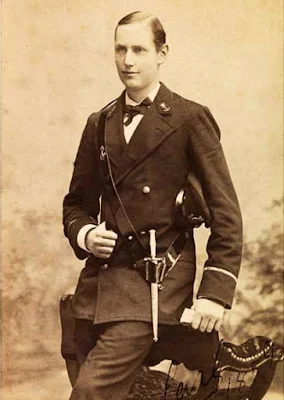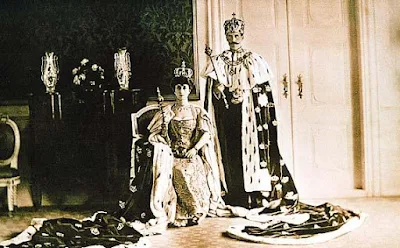WWII King Haakon VII of Norway
Prince Carl of Denmark was born on 3 August 1872 at the Charlottenlund
Palace near Copenhagen. He was the second son of Frederick, Crown
Prince of Denmark and his wife Louise of Sweden.
Family
Prince Carl of Denmark's paternal grandparents were King Christian IX
of Denmark and Louise of Hesse-Kassel.
His maternal grandparents were King Charles XV of Sweden and
Louise of The Netherlands.
Prince Carl was a member of the Schleswig-Holstein-Sonderburg-
Glücksburg, branch of the House of Oldenburg.
The family had permanent links with Norway beginning from the
late Middle Ages. Several of his paternal ancestors had been
kings of independent Norway (Haakon V of Norway, Christian I
of Norway, Frederick I, etc... ).
Education
Prince Carl was educated at the Royal Danish Naval Academy from
1889 to 1893, graduating as a second lieutenant in the Royal Danish
Navy. In 1894 he was promoted to the rank of first lieutenant and
remained in service with the Royal Danish Navy until 1905.
Love and Marriage
On 22 July 1896, Prince Carl married his first cousin! Princess Maud
of Wales, she was the youngest daughter of the future King Edward VII
of the United Kingdom and his wife Princess Alexandra of Denmark, the
eldest daughter of King Christian IX and Princess Louise.
Their son, Prince Alexander, the future Crown Prince Olav (who
later became King Olav of Norway) was born on 2 July 1903.
His way to power
In 1905, the Union between Sweden and Norway was dissolved and
a committee of the Norwegian government identified several princes
of European Royal Houses as candidates for the Norwegian Crown.
Although Norway had legally the status of an independent state
since 1814, it didn't have its own king since 1837.
Prince Carl became the leading candidate because he was descended
from independent Norwegian Kings. He also had a son, so an heir-
apparent to the throne. Besides that, Princess Maud was a member of
the British Royal Family was viewed by many as an advantage to the
newly independent Norwegian nation.
After the referendum overwhelmingly confirmed by a 79 percent
majority that Norwegians desired to retain a monarchy. Prince Carl
was formally offered the throne of Norway by the Storting (parliament)
and was elected on 18 November 1905.
When Carl accepted the offer that same evening, after the approval of
his grandfather Christian IX of Denmark, he renamed himself Haakon,
which is an Old Norse name.
The royal family of Norway left Denmark on the Danish royal yacht
Danneborg and sailed into Oslofjord. At Oscarsborg Fortress they
boarded the Norwegian naval ship Heimdal.
After a three-day journey they arrived in Kristiana, which is now Oslo,
on the morning of 25 November 1905.
Two days later, Haakon took the oath as Norway's first independent king
in 518 years. The coronation of Haakon and Maud took place in
Nidaros Cathedral in Trondheim on 22 June 1906.
On 20 November 1938, Queen Maud died unexpectedly during a visit
in the United Kingdom.
World War II
In the early hours of 9 April 1940, Norway was invaded by naval and
air forces of Nazi Germany.
The next day, Curt Bräuer, the German Minister to Norway, demanded
a meeting with Haakon. The diplomat asked Haakon to accept Hitler's
demands to end all reistance and appoint Vidkun Quisling as prime
minister.
Haakon told Bräuer that he could not make the decision himself, he only
could act on the advice of the Government.
"For my part I cannot accept the German demands. It would conflict with
all that I have considered to be my duty as King of Norway since
I came to this country nearly thirty-five years ago."
On 11 April 1940, the Luftwaffe bombers attacked Nybergsund, destroying
the small town where the Government was staying. Neutral Sweden was
only 16 miles away, but the Swedish government decided it would detain
and incarcerate King Haakon if he crossed their border (which Haakon
never forgave).
First, the Norwegian king and his ministers took refuge in the snow
covered woods and escaped harm, continuing farther north through
the mountains towards Molde on Norway's west coast.
As the British forces in the area lost ground under Luftwaffe
bombardment, the King and his party were taken aboard the British
cruiser HMS Glasgow. Later they exiled to the United Kingdom.
In the beginning King Haakon and Crown Prince Olav were guests
at Buckingham Palace, but at the start of the London Blitz, they moved
to Bowdown House in Berkshire. However the King's official residence
was the Norwegian Legation at 10 Palace Green in Kensington, which
became the seat of the Norwegian government in exile.
Haakon attended weekly Cabinet meetings and worked on the speeches
which were regularly broadcasted by radio to Norway by the BBC
World Service.
These broadcasts helped to cement Haakon's position as an important
national symbol to the Norwegian resistance. Many broadcasts were made
from Saint Olav's Norwegian Chruch in Rotherhithe, where the Royal
Family were regular worshippers.
Meanwhile in Norway, the people wore clothing or jewellery made from
coins bearing Haakon's 'H7' monogram as symbols of resistance to the
German occupation and of solidarity with their exiled King and
Government.
After the war, Haakon and the Norwegian Royal Family returned to
Norway aboard of the cruiser HMS Norfolk. They arrived with the
First Cruiser Squadron to cheering crowds in Oslo on 7 June 1945.
Death
On 21 September 1957, Haakon died at the Royal Palace of Oslo.
He became 85 years old. At his death, his son Olav succeeded him
as Olav V.
Haakon was buried on 1 October 1957, near his wife in the Royal
Mausoleum at Akershus Fortress.
Haakon VII is regarded by many as one of the greatest Norwegian
leaders of the pre-war period, managing to hold his young and
fragile country together in unstable politicial conditions.
Legacy
It always is nice to know which places or things were named after
this interesting royal.
* King Haakon VII Sea in East Antarctica is named in his honour
as well as the entire plateau surrounding the South Pole which was
named the King Haakon VII Vidde.
* In 1914 the Haakon County in the American State of South
Dakota was named in his honour.
* Two Norwegian Navy Ships were named after him:
- King Haakon VII (1942 - 1951);
- Haakon VII (1958 - 1974).
This was a new blog post in the World War II series about the royals
and their families. It always mentions their background and some of their
family ties. In the blog posts, I always try to give an objective image
of the royals.
Source pictures: Wikipedia









Comments